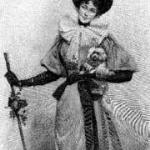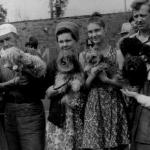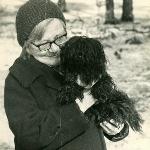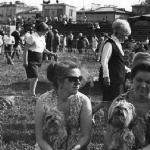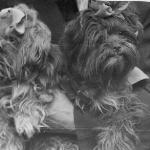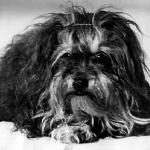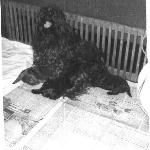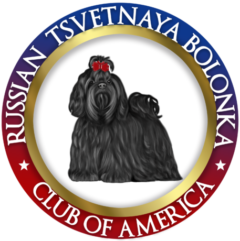Russian Tsvetnaya Bolonka History and Origin of the Breed in Russia
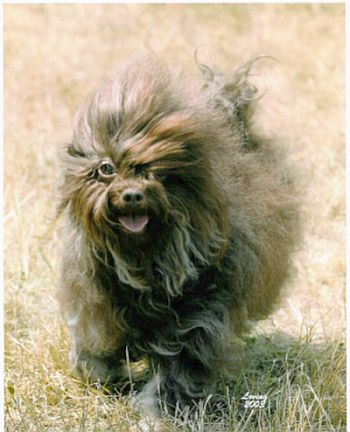
The history of the Russian Colored Lapdog, bred in Leningrad, is inseparably linked with the formation of all dog breeding in this city.
In the early 1950’s a group of enthusiasts set out to create a domestic decorative breed. Decorative dog breeding in general in Russia had long been in decline and developed under difficult conditions.
Zhanetta Avgustovna writes about the 10 years (1961-1971) of the initial development of the breed:
“During the years of Soviet rule in Leningrad, almost all exhibitions displayed, along with others, dogs of decorative breeds. However, the number and, most importantly, the quality of dogs at these shows were far from the same.
At the first post-war exhibition in 1946, only two decorative dogs (Lapdog and Toy Terrier) were presented, and at the exhibition, in 1947 only one decorative dog was exhibited. These figures testify to the extremely difficult conditions in which the fans in Leningrad began their work on breeding dogs.
The origins of the creation of the Russian Colored Lapdog, lie in the 1950s, and more precisely in 1951 when a group of dog lovers in the city of Leningrad whelped a black Lapdog named Tin-Tin from a mating of two coffee and white dogs. At that time, there were very few phenotypically suitable, dwarf dogs, and therefore the white color dog Trifon was brought to Leningrad from Hungary, and Zhuzhu, coffee-colored, was purchased from the circus that toured at that time in Leningrad. Some foreign dwarf breeds were also used, for example, Maltese, Bolognese, Shih Tzu, and some others. By the end of the 1950s, by the careful and rigorous selection, mainly by phenotype, and later on by the quality of the offspring, a fairly uniform population was obtained, which received the status of a breed group.”
American History of the Russian Tsvetnaya Bolonka
Although there were Russian Tsvetnaya Bolonki imported into the United States before 2000, many did not have registration papers nor were their owners interested in developing the breed in this country. It was not until the year 2000 when AKC Judge and Havanese breeder, Mrs. Candace Mogavero, became interested in the breed and imported a female, Ladushka Ocharovashka from Elvira Romanenkova, did interest in the breed become apparent. The following year another Havanese breeder, Ms. Patricia McRae, joined Ms. Mogavero and two more dogs were imported, Ladushki Rostok and Ladushki Kudrjashka. By 2002 Ms. Mogavero and Ms. McRae were joined by two more Havanese breeders Ms. Jane Falkenstein and Ms. Nancy Holmes. Three more female Bolonkas, Aljapka, Ladushki TsaTsa, Ladushki Toska, and one male, Ladushki Schlegel were then imported from Russia.
Ms. Mogavero and Ms. McRae planned to breed and show the breed in the rare breed organizations and to one day bring the breed to the AKC for recognition. They knew to do this they needed the dogs registered in the US and to do that they needed a breed club. They formed the North American Russian Tsvetnaya Bolonka Club and established a registry so the dogs could have American registrations. Most of the litters born were under Ms. McRae’s Ahavapicaro kennel name, while Ms. Mogavero did most of the showing of her dogs under her kennel name of Faireland Kennel and promoting the breed in the public eye.
Over the next few years, more breeders became interested in the development of the breed in this country and joined Ms. Mogavero and Ms. McRae in registering their imported dogs and puppies with the NARTB club. In the year 2015 the AKC accepted the breed into their Foundation Stock Service (FSS) and the club’s name was changed to the Russian Tsvetnaya Bolonka Club of America.
On January 1, 2023, the breed advanced to the AKC Miscellaneous Class.
The Russian Tsvetnaya Bolonka is also actively shown on the Rare Breed Circuit where it is recognized by the American Rare Breed Association (ARBA) and the International Canine Kennel Club (ICKC)
Today the Bolonka breed has a growing population of enthusiasts who hope to one day reach the goal of full AKC recognition.
